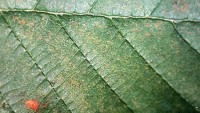Sequencing of Carrot Genome Might Lead to More Nutritious Future Versions
| Arthur Dominic Villasanta | | May 11, 2016 06:56 AM EDT |
(Photo : Phil Simon, UW–Madison, USDA-ARS) The many colors of carrots
The pigments that give carrots their familiar orange color also provide the nutrition found in this popular vegetable long associated with Bugs Bunny. And, because scientists have sequenced the carrot's full genetic code, the carrots of the future will be a lot more nutritious -- and colorful.
Like Us on Facebook
In fact, the first carrots cultivated in 1,100 years ago in Central Asia were purple and yellow in color. The familiar orange carrot only made its appearance in Europe in the 1500s.
These bits of trivia were among the more mundane uncovered by a team of researchers at the University of Wisconsin that recently deciphered the carrot's full genetic code. The team was led by geneticist Phil Simon, a horticulture professor at the University of Wisconsin-Madison. Its findings were published in the journal, Nature Genetics. The study's findings might also lead to the improvement of other crops.
"The carrot has a good reputation as a crop and we know it's a significant source of nutrition -- Vitamin A in particular," said Simon. "Now, we have the chance to dig deeper and it's a nice addition to the toolbox for improving the crop."
One finding is carrots have become good at accumulating carotenoids, the pigment compounds that give them their characteristic colors and provide their nutritional values. But more important, the genomic information has already been made available to assist in improving carrot traits such as enhanced levels of beta-carotene, drought tolerance and disease resistance.
The research team used the bright orange Nantes carrot to assemble and analyze the full genetic sequence. The carrot genome contains some 32,000 genes arranged among nine chromosomes. These chromosomes code for pest and disease resistance and colorful carotenoids, among other traits. Carotenoids such as alpha- and beta-carotene were first discovered in carrots.
"Going forward, the genome will serve as the basis for molecular breeding of the carrot," said co-author Allen Van Deynze, director of research at the University of California, Davis' Seed Biotechnology Center.
The study also discovered the genes for color and the genes associated with preferred flavors are not connected. It confirmed the pigments that give carrots their different colors are what make them nutritious.
And, by the way, orange carrots are the most nutritious of all, according to Simon, who is one of only a few carrot researchers in the world. Carrots are also the richest crop source of vitamin A in the American diet.
"The accumulation of orange pigments is an accumulation that normally wouldn't happen," said Simon. "Now, we know what the genes are and what they do."
Tagscarrots, Phil Simon, genetic code, University of Wisconsin-Madison, Vitamin A
©2015 Chinatopix All rights reserved. Do not reproduce without permission
EDITOR'S PICKS
-

Did the Trump administration just announce plans for a trade war with ‘hostile’ China and Russia?
-

US Senate passes Taiwan travel bill slammed by China
-

As Yan Sihong’s family grieves, here are other Chinese students who went missing abroad. Some have never been found
-

Beijing blasts Western critics who ‘smear China’ with the term sharp power
-

China Envoy Seeks to Defuse Tensions With U.S. as a Trade War Brews
-

Singapore's Deputy PM Provides Bitcoin Vote of Confidence Amid China's Blanket Bans
-

China warns investors over risks in overseas virtual currency trading
-

Chinese government most trustworthy: survey
-

Kashima Antlers On Course For Back-To-Back Titles
MOST POPULAR
LATEST NEWS
Zhou Yongkang: China's Former Security Chief Sentenced to Life in Prison

China's former Chief of the Ministry of Public Security, Zhou Yongkang, has been given a life sentence after he was found guilty of abusing his office, bribery and deliberately ... Full Article
TRENDING STORY

China Pork Prices Expected to Stabilize As The Supplies Recover

Elephone P9000 Smartphone is now on Sale on Amazon India

There's a Big Chance Cliffhangers Won't Still Be Resolved When Grey's Anatomy Season 13 Returns

Supreme Court Ruled on Samsung vs Apple Dispute for Patent Infringement

Microsoft Surface Pro 5 Rumors and Release Date: What is the Latest?













